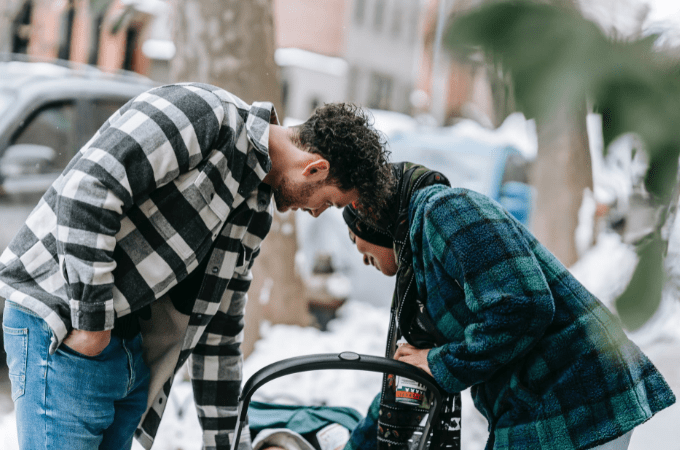Would you ever put your toddler or baby outside for a lunchtime nap in the freezing weather? It is part of the daily routine for most Nordic parents, and you will not find them giving it a second thought.
Babies nap in the outdoors in Norway and most of the other Scandinavian countries. They start making their babies snooze as young as two weeks old. However, the children are not just basking in a sunbeam on a mild summer afternoon, but you will also see them parked in prams on terraces and busy city sidewalks in all weathers, including days as cold as -4.
They back up this traditional practice with some pretty solid reasoning. Frigid napping increases the duration of sleep, as per Marjo Tourula of the University of Oulu’s thorough research. It also promotes better daytime sleeping. More subjectively, parents felt that making their kids nap outdoor in the fresh air enhanced their infant’s health.
Other benefits of napping outside include children being more energetic, capable of sleeping in any environment (even bright and loud), happier, and able to sleep better through the night. However, these benefits are not borne out by research yet.
If you live in the United States and want to go hucking your kid outside this winter, understand that Scandinavian parents in the United States have been arrested for this practice. Also, they equip their kids with sophisticated baby monitors and weather-appropriate bundling for safety.
In winter in Stockholm, the daytime temperature drops to -5C, but you will still see children left outside for a nap in the pram by their parents. Walk through the snowy city, and you will find buggies lined up outside of the restaurants or coffee shops.
According to the people of Stockholm, it is advantageous for their kids to be in the fresh air as soon as possible, especially in winter. Moreover, in Sweden, most of the daycare centers put kids outside to rest these days. It is common to see rows of prams lined up at nap time with babies sleeping in the snow. All the babies nap outside till the age of three at a pre-school outside Stockholm, Forskolan Orren.
The theory behind it is that the kids exposed to fresh air, whether in the depths of winter or summer, do not often catch colds and coughs. And spending the entire day with thirty other children in the same room does them no good at all.
Benefits of Outdoor Napping
The tradition these people follow has passed on by generations of Scandinavian parents. Fresh air is beneficial for the babies is the philosophy behind this traditional parenting choice. Following advantages of outdoor napping will make you include it in the daily schedule of your babies.
1. Outside Napping Can Boost Physical and Cognitive Development
The nervous system of your baby, when outside, receives serval sensory stimuli – lights, the sensation of wind, sounds, smells, and the warmth of the sun. The brain then processes all these signals and develops a new neuronal pathway- directly impacting intelligence.
Moreover, early sensory stimulation is beneficial for the development of cognitive, language, and motor skills. So, to grow a brainiac, increase your garden-fresh airtime with your baby.
2. Napping Outside Supports Immunity
When you put your child to sleep outside, his immune system meets several different germs and learns to produce antibodies. Do not worry about the word germs; there is a high possibility of catching flu or cold when you stay indoors at your home in winter.
Take a stroller and walk down the street or go to the park while your child is napping. It will make a substantial contribution to the overall health of your baby in the long term. However, you still need to make sure your child has appropriate clothes that keep him warm in the freezing temperature.
Also, avoid making him/her wear clothes that will make him/her sweaty. Excessive sweating can lead to hypothermia which can make your baby an easy target for viruses.
3. Napping in a Stroller Contributes to Deeper Sleep
Outside naps can also be favorable for the nighttime sleep of your baby. According to a 2004 study, babies who got sunlight exposure in the early afternoon had better sleep during the night hours. As compared to the babies who have more indoor time, exposure to sun and outdoor naps allows your child to develop healthy circadian rhythms.
Napping outside is tied to lower air temperature, which is another benefit. Lower temperature promotes the production of melatonin in the body of your child. It, in turn, makes them sleep restorative and deeper. Moreover, these babies also get used to the background noises, making them fall asleep anywhere as they grow older.
4. Outdoor Naps are an Excellent Self-Soothing Technique
The baby learns to soothe by the abundance of sensory stimuli. For example, while you are reading a book and sitting on a bench in the park, your baby explores the surrounding environment. Seeing clouds flowing in the sky and hearing leaves rustling may have a similar impact as those comforting toys you use to lull your baby to sleep.
Self-soothing is excellent because it teaches your kid to be more independent, and you get some sleep yourself, which is a plus point.
Conclusion
Due to several health benefits of outside napping, many parents are opting for this practice. Along with deeper sleep, cognitive and physical development, and enhanced immunity, these naps also promote healthy family relationships. They work as a great bonding time between the parents and the babies.
Norwegians are making their babies nap outside for ages, and they follow this traditional practice everywhere they go. Overall, spending more time with your baby outside the house is a good habit. Your children may inherit it from you as they get old.

